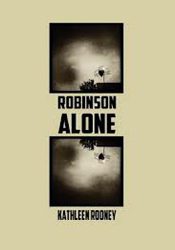
First things first: you don’t have to be a fan of Weldon Kees to enjoy this book. Shameful confession: until I read the note that precedes the table of contents, I’d never even heard of Weldon Kees or his Robinson poems, which Kathleen Rooney explodes into this novel in verse. And I still know little more than that which Rooney provides in her end notes–that Kees was, as Donald Justice put it, “one of the bitterest poets in history,” and that he disappeared in July of 1955 on the Marin County side of the Golden Gate Bridge.
It’s possible that a knowledge of Kees’ life would make a reader appreciate this book more–I’ll leave that to other reviewers to decide. What I know is that Rooney adeptly married verse and narrative and produced a fascinating work of art in Robinson Alone.
The book begins in Beatrice, Nebraska, where Kees was born, a town Rooney describes as “This hateful small. // This hateful empty. Civic & dutiful. / No not beautiful,” which sounds in some ways like the small southern towns I lived in as a kid, where everyone knew your business and didn’t hesitate to let you know it. Some people call it friendly. I found it stifling, and so did Robinson because he’s in New York as soon as he gets the chance, and he knows what he wants. From “Robinson Walks Museum Mile”:
Do museums
amuse him? Yes, but not today. Would he
like to be in one? Of course. Why not?
An object of value with canvas wings,
an unchanging face in a gilt frame, arranged–
thoughtless, guilt-free, & preserved
for eternity. Robinson does want to be
exceptional. He knows he is. He wants to be
perceived exceptional.
It’s fascinating the way Rooney casts Robinson as both confident in his abilities as a musician and artist and yet self-negating, unsure, as though he can’t be considered a success unless others recognize him as one.
I’ve had mixed feelings about novels in verse in the past, perhaps because I’ve felt that too often the poetry gets sacrificed to the story. That doesn’t happen here. Read these lines aloud and listen for the music in them:
Robinson Ice-Skates at Rockefeller Center
though he’ll readily admit: he’s no outdoorsman.
Natural beauty can floor him. Then? Boredom.
Yet skating elates. Skating exhilarates. Invigorates,
sans irony, his childhood memory: iron skates
made in his grandfather’s factory. Racing
across the ice, Robinson traces ampersands.
The energy of the first lines is palpable, and the repeated long a’s in lines 3-6 make the poem pick up speed until we’re flying along the ice along with Robinson until two-thirds of the way through
Robinson imagines a fight inside him: anomie
v. bonhomie, each a skate blade–no,
a pistol. Cruel smile v. nice. Each taking twenty
paces then facing off. A duel! Who’ll win?
As I read about Robinson’s relationship with his wife Ann, I couldn’t help but think of Kate Zambreno’s Heroines. Ann isn’t portrayed here quite like Zelda Fitzgerald or Viv Eliot–an artist in her own right bled dry by her husband and institutionalized when she became inconvenient–but she does share their fate. She’s an alcoholic who has a psychotic episode and who winds up institutionalized and divorced, and left behind.
Rooney makes use of her prodigious personal talents throughout this book, but she’s also good at making use of found text. She created 15 centos out of Kees’ writing, all titled “Robinson Sends a Letter to Someone.” They trace Robinson’s decay. In Cento II, for example, Robinson is formal, straight. His letter to the unnamed someone is about his worry that he’ll be drafted (World War II was raging at the time) and the language reflects his terse worry. “Everyone said that if you told the draft / board you were a bedwetter / you were a cinch for Class 3D,” he says, while noting that his attempts to look for a job have been hampered by his high eligibility status. But by Cento VIII, Robinson is having problems:
I find myself becoming more & more anti-social:
it is an ordeal to get myself out of the house
& there are fewer people I care about seeing.
It may be the end of New York as a romantic idea.
By Cento XIV, it’s clear the end is nigh for Robinson. “Had any interesting dreams? / I am discouraged, indeed, about my own dream life–/ repetitive & moth-eaten–so tiresome / I’d give a good deal not to have them any more.”
 And yet, for me, the most painful moment of the book doesn’t involve Robinson at all. It’s a poem about his cat, left alone as Robinson neglects everything near the end of his life. Rooney writes “the cat walks the keys of the piano / all night, longing / for a hand to gently remove him.” The cat’s name is, appropriately enough, Lonesome.
And yet, for me, the most painful moment of the book doesn’t involve Robinson at all. It’s a poem about his cat, left alone as Robinson neglects everything near the end of his life. Rooney writes “the cat walks the keys of the piano / all night, longing / for a hand to gently remove him.” The cat’s name is, appropriately enough, Lonesome.
This isn’t a new story–a recent study from Sweden found that people in what researchers called “creativity-based careers” were more likely to suffere from bipolar disorder, and authors were about twice as likely to commit suicide as the general population. So it’s fair to ask, do we really need to read this story again? I think, in this case, the answer is yes.
Read “Southern Wind, Clear Sky,” a Rumpus Original Poem by Kathleen Rooney and Elisa Gabbert.




